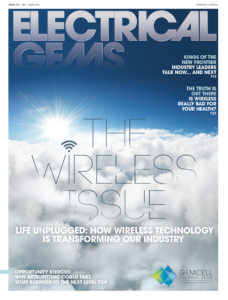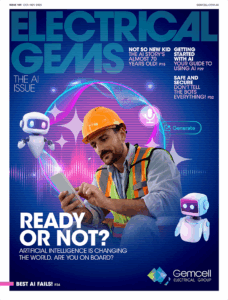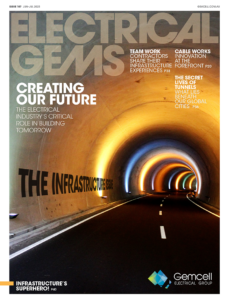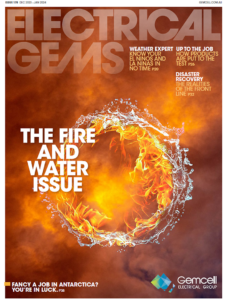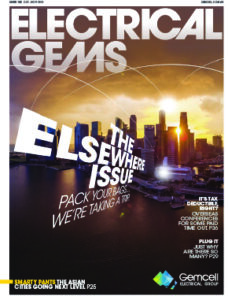Electrical and data cables generally go unnoticed – until something goes wrong, of course. But behind the scenes, innovation in cable is paramount in order to deal with the infrastructure needs of today, and the demands of tomorrow.
As large-scale infrastructure projects grow and grow, so too does the technological innovation required to support them.
After all, without the right materials – and the right connectivity – there aren’t many large-scale projects that would succeed.
And electrical and data cable is key, with the demands of smart tech driving the cabling sector forward.
“As the demand for efficient power distribution and telecommunications has grown, so too has the need for advanced cable technology that can support these developments,” says Scott Moore, National Certification Manager at Electra Cables.
“The integration of smart grid technologies into modern infrastructure has necessitated innovations in cable systems. These cables are now equipped with monitoring capabilities that provide real-time data on performance and functionality, allowing for more efficient maintenance and operation.”
Keeping connected with electrical and data cable
Cable advancements to support large-scale infrastructure aren’t just limited to the influence of smart tech, of course. With increasing demands come higher voltages and greater power loads, while enhanced durability is also a common prerequisite, particularly for projects located in some of the harsher locations in the country.
The ability to withstand extreme weather is an imperative, as is the need to have some strong sustainability creds.
Scott says, “As the world becomes increasingly eco-conscious, there is a push for sustainable practices in all production sectors, including cable manufacturing. This has spurred the development of cables that utilise recyclable materials and energy-efficient production processes, aligning with the sustainability goals of smart infrastructure.”
And when it comes to safety, it’s increasingly important for cables to be able to withstand the heat, says John Waller, Regional General Manager at CABAC.
“We are seeing more and more fire-rated fibre cable that will continue to operate for 120 minutes when exposed to flame being installed,” he says.
“Both six and 12-core single-mode fibres are the most popular, and while these are not new to the market, the innovative design has changed to guarantee critical operation for the full 120 minutes and beyond.”
The challenges of mega projects
Across the globe, we’re seeing huge projects pop up almost everywhere. Each one presents some unique challenges for all parties, including those responsible for bringing the connections. Cable suppliers are facing a whole host of challenges, whether it’s a renewable energy project or a new smart city.
“The sheer scale of mega-projects often leads to unpredictable demand for cables, complicating inventory management and production planning. Suppliers must accurately forecast needs, which can fluctuate significantly based on project timelines and regulatory changes,” says Scott.
“Navigating complex regulations and standards specific to different markets can also be difficult. Compliance with environmental standards, safety requirements, and international regulations can slow down production processes and impact project timelines.”
At CABAC, John says that time is often a key challenge when supplying cable for larger infrastructure projects.
“The lack of notice given to supply cables in a timely manner can be an issue. Most of the cables used in these large projects are made to order with long manufacturing lead times out of Europe.”
Those demands mean project management skills are in high demand – and incredibly important.
“Large-scale projects require high levels of coordination and project management,” says Scott.
“Suppliers need to align their production and delivery schedules with project timelines, often having to adapt to delays and changes in project scope.”
Improving electrical and data cable performance
However, regardless of the type of project it’s used for, cabling continues to advance and develop. Meeting today’s expectations is one thing; foreseeing the uses of tomorrow and developing products suitable for use in years to come is another altogether.
Advancements in materials are an area for constant development. After all, the longer cables last, and the more durable they are to their environment, the better for all concerned.
Quality and consistency is key here.
“The use of new, high-performance materials for insulation and conductors, such as low-density polyethylene (LDPE) and polypropylene, enhances the durability and flexibility of cables,” says Scott. “These materials resist environmental factors and abrasion better than traditional materials.”
Advances in manufacturing processes, such as improved wire drawing techniques and precision extrusion, result in cables with fewer defects and greater consistency, and ultimately boost performance.
Scott believes that together with shielding technology, thermal management, strain relief mechanisms and environmental resistance, these factors are creating a new generation of cabling.
“They not only help meet the increasing demands of modern technology but also ensure greater longevity and reliability in various applications,” he says.
So, while it may often go unnoticed day-to-day, there are a lot of smart people giving cabling their undivided attention to ensure that the infrastructure projects we all rely on work as well as they possibly can.
5 cable innovations to watch
Scott Moore of Electra Cables shares his top 5 innovations to watch in the coming years.
Optical fibre advancements
The introduction of higher-capacity optical fibre, such as those designed with advanced glass compositions, will enable faster data transmission with reduced energy loss. Innovations like hollow-core optical fibre could also revolutionise the way data travels by minimising the effects of dispersion and attenuation.
Smart cables
These cables incorporate sensors to monitor performance in real time. They can notify operators of potential issues such as temperature changes or degradation, allowing for timely maintenance and reducing downtime.
Sustainable materials
With a growing emphasis on sustainability, the use of biodegradable or recyclable materials for cable sheathing and insulation is gaining traction. Bioplastics and recycled materials can reduce the environmental impact of cabling systems.
Cable-laying robots
Automation in the laying of cables, such as autonomous underwater drones that can install subsea cables, will become more common. This technology not only speeds up installation but also minimises disruption to the environment.
5G and beyond
The rollout of 5G technology necessitates new forms of cabling, such as dense wavelength-division multiplexing (DWDM), to support the required bandwidth. Future explorations might even see cables designed specifically for quantum communications.
Read more about… non-compliant cabling
If you’re installing cabling, you need to ensure it’s compliant.
Click here to learn everything you need to know about non-compliant cabling.






















